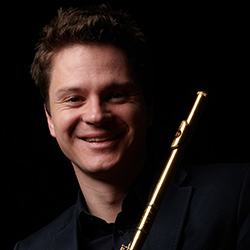| 場次 | 場地 | 音樂家 |
|---|---|---|
| 2024/04/27(六)19:30 國立臺灣交響樂團演奏廳 |
|
卡爾.海因茨.舒茲 Karl-Heinz Schütz
|
| 2024/04/28(日)14:30 衛武營國家藝術文化中心音樂廳 |
|
卡爾.海因茨.舒茲 Karl-Heinz Schütz
|
預計2023/08/14(一)中午12:00啟售,08/14-08/21為NTSO 2023/24 VIP限定,08/21(一)中午12:00全面啟售。*成為NTSO VIP請點擊了解詳情
【2023/24樂季特惠方案】
★「藝套票」、「鍾愛霧峰套票」:享每張111元特惠價,詳情請點擊場次總覽說明。
★來去衛武營套票:衛武營音樂廳任選2場享6折,詳情請點擊場次總覽說明。
★「成雙」套票:同場次一次訂購2張,第2張半價(須同票價)
★成年禮金(文化幣):使用文化幣點數購票,享最高票價區「青年席位300元」或不限票價6折優惠(需全額以文化幣點數支付,相關成年禮金使用指南請點擊了解)

NTSO 2023/24樂季
NTSO 舒茲與國臺交
Karl-Heinz Schütz & NTSO
2024/04/27(六)19:30 國立臺灣交響樂團演奏廳(臺中市霧峰區中正路738-2號)
2024/04/27(Sat.)19:30 NTSO Concert Hall
*周邊停車資訊
2024/04/28(日)14:30 衛武營國家藝術文化中心音樂廳(高雄市鳳山區三多一路1號)
2024/04/28(Sun.)14:30 Concert Hall of National Kaohsiung Center for the Arts (Weiwuying)
音樂會前導聆|於音樂會演出前1小時由羅文秀主講,憑當天音樂會門票入場參加(由夜鶯基金會合作提供)
指揮、長笛/卡爾.海因茨.舒茲
Conductor & Flute: Karl-Heinz Schütz
【曲目】Program
理查.史特勞斯:交響曲《快樂工坊》,為十六件管樂器
R. Strauss: Symphony for Wind Instruments “The Happy Workshop”
莫札特:G大調第一號長笛協奏曲
W. A. Mozart: Flute Concerto No.1 in G Major, K. 313
莫札特:第三十一號交響曲《巴黎》
W. A. Mozart: Symphony No. 31 in D Major, K. 297 “Paris”
【節目長度參考】約110分(含中場休息)
*以上演出內容或順序等若有異動,以實際演出為準。
【票價】
臺中場 NT 300、500、800、1000
高雄場 NT 300、500、800、1000、1500
*歡迎大量購票(30張以上),專案優惠請洽主辦單位(04)23391141分機153,ntso153@ntso.gov.tw
指導單位:文化部
主辦、演出單位:國立臺灣交響樂團
音樂欣賞推廣協力:臺灣證券交易所
購票請洽OPENTIX兩廳院文化生活
各項優惠請點擊詳閱說明
成為NTSO 2023/24 VIP(請點擊)
活動洽詢電話:國立臺灣交響樂團04-23391141(代表號)
NTSO YouTube (超過780萬瀏覽次數)
NTSO線上音樂廳
NTSO《樂覽》雜誌
NTSO照亮古典
NTSO國立臺灣交響樂團LINE官方帳號
更多國臺交精彩畫面及音樂會訊息,請造訪國臺交Facebook粉絲專頁
這可以說是一場在卡爾.海因茨.舒茲的指揮與獨奏下,向莫札特致敬的音樂會。木管樂器群的色彩調配、輕盈與精妙手法,是莫札特最受稱道之處,表現在交響曲、室內樂與協奏曲之中。
理查.史特勞斯在晚年為十六件管樂器所寫的《快樂工坊》,也是在追求莫札特那般澄澈的聲響。而莫札特之所以能揮灑木管樂器,是因為雙簧木管樂器與橫笛在法國宮廷中得到長足的發展。在路易十四的支持下,木管樂器受到貴族喜愛,吹奏橫笛也成為歐陸的風尚。盧利也投路易十四所好,整合宮廷的音樂資源,將木管樂器併入弦樂團,為後來的管弦樂團打下基礎。講究華麗喧嘩的流風所及,也難怪《巴黎》交響曲的編制龐大、排場熱鬧,超越了莫札特其他的交響曲。
理查.史特勞斯的《快樂工坊》的編制是將木管五重奏擴大而成:五件樂器各乘以二,然後增加兩把法國號,又增加了單簧管、巴塞管、低音單簧管與倍低音管各一。這讓法國號的編制達到大型管弦樂團的規模,其他低音木管的加入,會讓整體聲響更為厚實暗沉。
《快樂工坊》寫於二戰末期,德國戰敗的命運已是不可避免,納粹雖然禮遇理查.史特勞斯,但並非真心接納,而理查.史特勞斯也只能保持表面的和諧。在此狀況下,作曲家以純熟的技巧驅動樂思,寄情於莫札特的純真,反而更顯得世局晦暗。(撰文/吳家恆)
Conducted by Karl-Heinz Schütz, who is also the soloist, this concert pays tribute to Mozart. Popular features such as bright color schemes as well as the lightness and subtleness of woodwind ensembles are present in his symphonies, chamber music, and concertos.
Richard Strauss’ “The Happy Workshop” for sixteen wind instruments, which was completed in his later years, aimed to emulate Mozart’s crystal-clear sound.
Woodwind instruments gained popularity among the nobles with the support of French King Louis XIV, and playing the flute became extremely fashionable throughout Europe. The flute and double-reed woodwind instruments were extensively developed in the French court, which is why Mozart was such a master of them. Jean-Baptiste Lully also went along with Louis XIV’s preferences and incorporated woodwind instruments into the string orchestra, laying the foundation for future orchestras. Given the loud and extravagant trends, it is not surprising that the arrangement of the large and lively Paris Symphony surpasses Mozart’s other symphonies.
Richard Strauss expanded the original woodwind quintet in his “The Happy Workshop”: there is double of each of the five instruments, then he added two French horns, followed by a clarinet, a basset horn, a bass clarinet, and a double bassoon. This formation has the same number of French horns as a large orchestra, plus the addition of other bass woodwinds thickens and darkens the overall sound.
“The Happy Workshop” was written at the end of World War II when Germany’s defeat was inevitable. Although the Nazis treated Richard Strauss with courtesy, they did not really accept him; and Richard Strauss, in turn, just maintained basic politeness. Under such circumstances, the composer turned to Mozart’s innocence for inspiration, which further highlighted the darkness of the world’s situation.
更新日期2023.9.19


.jpg)